

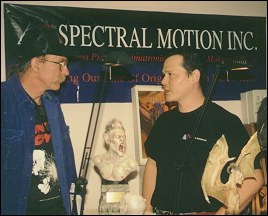
|
Wayne "The Dane" Hansen and Mike Elizalde at Spectral Motions booth during the 1996 fall Chiller Theatre Show. |
![]() Tell us your full name and a little bit about your background.
Tell us your full name and a little bit about your background.
![]() My name is Winston Miguel Elizalde, I go by Mike Elizalde, everyone calls me that. I was
born in 1960 in Mazatlan Mexico and I'm 36 years old. I didn't grow up in
Mexico. My family immigrated to the United States when I was four years old. I
attended school throughout southern California, most notably in Compton
where I spent six years of my elementary school learning. After that we lost the
settled feeling that we had and we moved around a lot. I went to about 12
elementary schools after leaving Compton. After my mother passed away,
when I was 14, in 1974, I then went to live with a foster family in Orange
county. I went to Catholic school there for a while, called St. Joseph's of Santa
Ana. After that I got settled in with an uncle I attended Alhambra High School,
four years. I graduated in 1979. I joined the military and spent 8 years serving
in the navy. I was stationed on the island of Guam for 4 years. I learned a lot of
machining skills, electronic troubleshooting, things that help me with my career
now. Two years before I left the navy, I discovered that I wanted to be a make-
up artist. That 's when I found the book by Lee Baygan, The Techniques of
3-Dimensional Make-up. I studied that book and created my first make-up on
myself. I just sort of grew from there, sharpening my sculpting skills, my mold-
making, etc.
My name is Winston Miguel Elizalde, I go by Mike Elizalde, everyone calls me that. I was
born in 1960 in Mazatlan Mexico and I'm 36 years old. I didn't grow up in
Mexico. My family immigrated to the United States when I was four years old. I
attended school throughout southern California, most notably in Compton
where I spent six years of my elementary school learning. After that we lost the
settled feeling that we had and we moved around a lot. I went to about 12
elementary schools after leaving Compton. After my mother passed away,
when I was 14, in 1974, I then went to live with a foster family in Orange
county. I went to Catholic school there for a while, called St. Joseph's of Santa
Ana. After that I got settled in with an uncle I attended Alhambra High School,
four years. I graduated in 1979. I joined the military and spent 8 years serving
in the navy. I was stationed on the island of Guam for 4 years. I learned a lot of
machining skills, electronic troubleshooting, things that help me with my career
now. Two years before I left the navy, I discovered that I wanted to be a make-
up artist. That 's when I found the book by Lee Baygan, The Techniques of
3-Dimensional Make-up. I studied that book and created my first make-up on
myself. I just sort of grew from there, sharpening my sculpting skills, my mold-
making, etc.
![]() So that's all self-taught?
So that's all self-taught?
![]() Pretty much, from that book. That whole period of
time, two years prior to leaving the navy, I pretty much just educated myself on
the subject with whatever materials I could get a hold of. Once I left the navy to
get involved with the film industry, I can't believe how warm and generous
everyone in the film industry has been in sharing their knowledge. It's been on
the job training ever since. I've never been to any formal schools for make-up
effects or animatronics design. Everything that I've learned is from very
generous people that I've worked with over the years. It's been really fulfilling.
Pretty much, from that book. That whole period of
time, two years prior to leaving the navy, I pretty much just educated myself on
the subject with whatever materials I could get a hold of. Once I left the navy to
get involved with the film industry, I can't believe how warm and generous
everyone in the film industry has been in sharing their knowledge. It's been on
the job training ever since. I've never been to any formal schools for make-up
effects or animatronics design. Everything that I've learned is from very
generous people that I've worked with over the years. It's been really fulfilling.
![]() Give us a capsule, a chronological chain of events, including the titles of films
you worked on and which companies you were employed by.
Give us a capsule, a chronological chain of events, including the titles of films
you worked on and which companies you were employed by.
![]() The first
company that I was employed by in the film industry was John Beuchler's MMI I
worked on a film called Arena and it was there that I met Steve Wang and
Screaming Mad George, among other prominent figures in the make-up
effects industry. That was a tremendous opportunity. I
was on cloud nine. I was wandering about with great talent all around me. I
was learning as much as I could and picking up as many tips from the guys as
they would give. They gave a lot of tips! They were very generous and
considerate. I'm grateful for that. After Arena, I left MMI to go to work for David
Miller. The first thing I worked with him on was a film called Gnaw! Food of the
Gods II. As I worked with David he gave me more and more responsibility,
to the point where I became head make-up artist.
The first
company that I was employed by in the film industry was John Beuchler's MMI I
worked on a film called Arena and it was there that I met Steve Wang and
Screaming Mad George, among other prominent figures in the make-up
effects industry. That was a tremendous opportunity. I
was on cloud nine. I was wandering about with great talent all around me. I
was learning as much as I could and picking up as many tips from the guys as
they would give. They gave a lot of tips! They were very generous and
considerate. I'm grateful for that. After Arena, I left MMI to go to work for David
Miller. The first thing I worked with him on was a film called Gnaw! Food of the
Gods II. As I worked with David he gave me more and more responsibility,
to the point where I became head make-up artist.
![]() So at this time, you were mainly doing prosthetic type work, not so much
mechanical stuff.
So at this time, you were mainly doing prosthetic type work, not so much
mechanical stuff.
![]() Yes, the first five or six years of my career were make-up,
sculpting, and mold-making. That's where my energies were being
concentrated. Around the time I was working at Dave Miller's shop, on a film
called Nothing But Trouble with Dan Aykroid, I met a gentleman named
David Nelson, and he was David Miller's main mechanical designer. I was
fascinated by his work. It's clean, precise, everything that he made worked
beautifully. That's what interested me. I said, I want to do that, I want to make
stuff like this and make it realistic.
Yes, the first five or six years of my career were make-up,
sculpting, and mold-making. That's where my energies were being
concentrated. Around the time I was working at Dave Miller's shop, on a film
called Nothing But Trouble with Dan Aykroid, I met a gentleman named
David Nelson, and he was David Miller's main mechanical designer. I was
fascinated by his work. It's clean, precise, everything that he made worked
beautifully. That's what interested me. I said, I want to do that, I want to make
stuff like this and make it realistic.
![]() Did he make mechanical stuff for Nothing But Trouble?
Did he make mechanical stuff for Nothing But Trouble?
![]() No, he did
mechanical stuff for a movie called Watchers. Actually that's when I met him,
on Watchers. He did great stuff with a mediocre design. He just brought the
thing to life and made it look really cool.
No, he did
mechanical stuff for a movie called Watchers. Actually that's when I met him,
on Watchers. He did great stuff with a mediocre design. He just brought the
thing to life and made it look really cool.
![]() That was a Cory Haim one from the Dean R. Koontz book?
That was a Cory Haim one from the Dean R. Koontz book?
![]() Yeah, that's right.
That dog creature thing, really odd looking. The book was much better! That's
when I became influenced by his knowledge of mechanics. I told David Miller,
I said, "Dave, I really would like to try this. I'd like to be able to design this
mechanical stuff. So, Dave gave me the opportunity, on more than one
occasion he said "Go ahead and do the mechanics on these." That proved to
be very rewarding.
Yeah, that's right.
That dog creature thing, really odd looking. The book was much better! That's
when I became influenced by his knowledge of mechanics. I told David Miller,
I said, "Dave, I really would like to try this. I'd like to be able to design this
mechanical stuff. So, Dave gave me the opportunity, on more than one
occasion he said "Go ahead and do the mechanics on these." That proved to
be very rewarding.
![]() That was when the mechanical skills you learned in the Navy came in
handy.
That was when the mechanical skills you learned in the Navy came in
handy.
![]() Right. Although there wasn't any real crossover, there was a background
that helped.
Right. Although there wasn't any real crossover, there was a background
that helped.
![]() Right, you know how to use a lathe and a mill and a drill press.
Right, you know how to use a lathe and a mill and a drill press.
![]() Exactly. So I
started designing stuff for Dave. From that point on I fluctuated back and forth
between sculpture and mechanical design. So I've always kept both of those
skills pretty much alive and I still do today. I love to sculpt. It's my favorite thing
to do, when I'm not doing it for
somebody else. Because at that point it becomes work and becomes
their design with their parameters. It's really not a very free thing.
Exactly. So I
started designing stuff for Dave. From that point on I fluctuated back and forth
between sculpture and mechanical design. So I've always kept both of those
skills pretty much alive and I still do today. I love to sculpt. It's my favorite thing
to do, when I'm not doing it for
somebody else. Because at that point it becomes work and becomes
their design with their parameters. It's really not a very free thing.
![]() Yea, there are deadlines and pressures.
Yea, there are deadlines and pressures.
![]() Exactly. And although I do believe in
imposing deadlines on myself when I'm sculpting something, it's my deadline,
it's definitely my design. That's where I get the highest degree of gratification
out of sculpture. At work, such as when I go to work for Rick Baker, it's a
different story. When I design animatronic heads or whatever I'm doing for
Rick, that's very rewarding. He's very honest. He'll tell you right there and then
if he doesn't like something. The nice thing about Rick is that he never loses
his temper, he never becomes agitated. He'll look at something and very
calmly say, "I don't like it, fix it." That's the way Rick handles things, which is
great. That's all I can ask for in a boss. He's very good that way.
Exactly. And although I do believe in
imposing deadlines on myself when I'm sculpting something, it's my deadline,
it's definitely my design. That's where I get the highest degree of gratification
out of sculpture. At work, such as when I go to work for Rick Baker, it's a
different story. When I design animatronic heads or whatever I'm doing for
Rick, that's very rewarding. He's very honest. He'll tell you right there and then
if he doesn't like something. The nice thing about Rick is that he never loses
his temper, he never becomes agitated. He'll look at something and very
calmly say, "I don't like it, fix it." That's the way Rick handles things, which is
great. That's all I can ask for in a boss. He's very good that way.
![]() So you were working on Watchers; let's continue chronologically from that
point.
So you were working on Watchers; let's continue chronologically from that
point.
![]() After Watchers came a few other movies with Dave Miller, One Good Cop,
and a Martin Short one called "Clifford". Then, a couple more Nightmare
on Elm Street movies.
After Watchers came a few other movies with Dave Miller, One Good Cop,
and a Martin Short one called "Clifford". Then, a couple more Nightmare
on Elm Street movies.
![]() For David or for someone else?
For David or for someone else?
![]() I went to work for Todd Masters on a
Nightmare movie in the interim and then came back to Dave Millers for
Nothing But Trouble with Dan Akroid. While I was working for Dave Miller, he
let me do a lot of different things so I sort of became a Jack of all Trades,
which was really good. After that I went to work for Amalgamated Dynamics
for a while. I did a show called The Santa Clause. I was the main designer of
the animatronic reindeer. That was my first big assignment, as far as being in
charge of all the design work and the mechanics. It was really great. Alec
Gillis and Thom Woodruff really put a lot of trust in me.
I went to work for Todd Masters on a
Nightmare movie in the interim and then came back to Dave Millers for
Nothing But Trouble with Dan Akroid. While I was working for Dave Miller, he
let me do a lot of different things so I sort of became a Jack of all Trades,
which was really good. After that I went to work for Amalgamated Dynamics
for a while. I did a show called The Santa Clause. I was the main designer of
the animatronic reindeer. That was my first big assignment, as far as being in
charge of all the design work and the mechanics. It was really great. Alec
Gillis and Thom Woodruff really put a lot of trust in me.
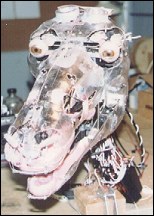 |
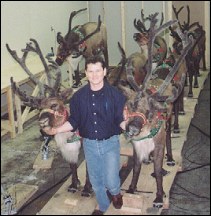 |
|
Animatronic Reindeer head "Coment" from The Santa Clause. Mechanical design by Mike Elizalde. |
Mike with the whole reindeer team. |
![]() Did you sculpt them as well?
Did you sculpt them as well?
![]() No, I didn't sculpt them. The cosmetic work was
done by ADl's staff of sculptors and character designers. But just before that I
was working with Dave Nelson in Agoura Hills at his company called
Animated Engineering. That was a great experience working directly with
Dave Nelson as one of the mechanical designers. Again, he's one of those
people who demands the best.
No, I didn't sculpt them. The cosmetic work was
done by ADl's staff of sculptors and character designers. But just before that I
was working with Dave Nelson in Agoura Hills at his company called
Animated Engineering. That was a great experience working directly with
Dave Nelson as one of the mechanical designers. Again, he's one of those
people who demands the best.

|
|
Fluke puppy head. Design by Dave Nelson and Mike Elizalde. |
![]() I'm not that familiar with Dave Nelson's career. Can you tell us some of the
films that he's done?
I'm not that familiar with Dave Nelson's career. Can you tell us some of the
films that he's done?
![]() He did a film called Fluke, and he did the Yoshi dinosaur puppet for Super
Mario Brothers the Movie, and a fake head of Christopher Lloyd for an
episode of Amazing Stories while in Stan Winston's employ. He was also a
chief mechanical designer for Chucky under Kevin Yagher, so he's done quite
a bit of work.
He did a film called Fluke, and he did the Yoshi dinosaur puppet for Super
Mario Brothers the Movie, and a fake head of Christopher Lloyd for an
episode of Amazing Stories while in Stan Winston's employ. He was also a
chief mechanical designer for Chucky under Kevin Yagher, so he's done quite
a bit of work.
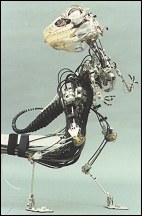 |
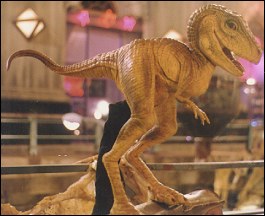 |
|
Yoshi from Super Mario Brothers. Animatronic design by Dave Nelson of Animated Engineering. |
Yoshi with skin. Designed by Mark Maitre. |
![]() So you worked for him on Super Mario Brothers?
So you worked for him on Super Mario Brothers?
![]() Yes, we worked together
on Super Mario Brothers. We were really proud of the Yoshi puppet. Dave
designed most of that and let us design parts of it. It turned out wonderfully.
That's when Dave recommended me to ADI. And I also worked for them on
Jumanji for a short time. After I left ADI, I went to work for Steve Johnson's
XFX Inc. for a while. I worked on Sil for Species. I designed her eyes. What
made this special was they wanted necticating membranes as well as
primary lids all in the same mechanism. It was a pretty tall order. It was a very
fulfilling assignment. When we took that puppet to set, and everybody saw the
eyes rolling and opening they were pretty impressed. It was a fantastic
experience for all of us. Steve was so proud of us. It's got to be one of the
highlights of my career.
Yes, we worked together
on Super Mario Brothers. We were really proud of the Yoshi puppet. Dave
designed most of that and let us design parts of it. It turned out wonderfully.
That's when Dave recommended me to ADI. And I also worked for them on
Jumanji for a short time. After I left ADI, I went to work for Steve Johnson's
XFX Inc. for a while. I worked on Sil for Species. I designed her eyes. What
made this special was they wanted necticating membranes as well as
primary lids all in the same mechanism. It was a pretty tall order. It was a very
fulfilling assignment. When we took that puppet to set, and everybody saw the
eyes rolling and opening they were pretty impressed. It was a fantastic
experience for all of us. Steve was so proud of us. It's got to be one of the
highlights of my career.
 |
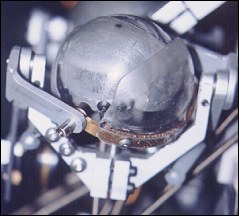 |
|
Animatronic Sil head from Species. Design by Mike Elizalde, Eric Fiedler, and Scott Oshita. |
Close up of Sil's eye mechanism from Species. Design by Mike Elizalde. |
![]() So then where did you go?
So then where did you go?
![]() After I left Steve Johnson's, I went to Rick Baker's.
The first project that I worked on there was Batman Forever. I was hired as
Mark Setrakian's assistant. He's Rick's chief mechanical designer. He's a
fantastic designer. He solves problems. He can sit there and think about what
to do and he comes up with solutions. It's great to work with him because it's
extremely educational. He's a master and the more prolific the master, the
more proficient the student. So I'm really grateful for the opportunity to work
there. After Batman Forever, I worked on The Nutty Professor, and then Men
In Black. And that brings us up to now. We're working on Mighty Joe Young
right now.
After I left Steve Johnson's, I went to Rick Baker's.
The first project that I worked on there was Batman Forever. I was hired as
Mark Setrakian's assistant. He's Rick's chief mechanical designer. He's a
fantastic designer. He solves problems. He can sit there and think about what
to do and he comes up with solutions. It's great to work with him because it's
extremely educational. He's a master and the more prolific the master, the
more proficient the student. So I'm really grateful for the opportunity to work
there. After Batman Forever, I worked on The Nutty Professor, and then Men
In Black. And that brings us up to now. We're working on Mighty Joe Young
right now.
![]() So, tell us about how Spectral Motion got started.
So, tell us about how Spectral Motion got started.
![]() Spectral Motion
came about as a special effects company with our ultimate goal to be doing our own
character designs for films. As time has progressed, we find ourselves
designing and releasing model kits. One of the people that attend the Mad
Model Party convention here in California every year is director John Landis.
He likes to keep up with what's out there. So, I look at models as a good
opportunity to expose my work to a mass audience. We are currently working
on a make-up design based on our Alex the Vampire bust kit, which we will
premier at the Mad Model Party in April if our schedule permits. My wife,
Mary, and I started the
company together and she has been like a guiding light to me. She keeps me
extremely organized. She's the driving force in this equation. She's mainly
responsible for making sure the bills are paid, filling orders, and keeping me
motivated. She was a dancer and a physical conditioning instructor. One of
the things she knows a lot about is anatomy and physical movement. So she's
really tuned into the human body, what it does, how it works. About 10 years
ago she suffered an auto accident where she was a pedestrian and a car
struck her. Over a long period of rehabilitation, she learned a great deal so
this makes her ideal as my official anatomical director for the company. So, if
ever I get stuck when I'm sculpting, I just go to her and she tells me where my
anatomy is wrong. When it comes to advertising, that's something that I'm
really interested in. I design the ads and the layout etc. The ad that was on the
back of Amazing Figure Modeler was done by David Fisher based on a
design sent to him by me. I do a lot of work on the computer such as laying out
our box art and our ads. Mary handles the computer with a lot of the
bookkeeping and orders, accounts payable, etc. So this is the foundation on
which Spectral Motion has been built.
Spectral Motion
came about as a special effects company with our ultimate goal to be doing our own
character designs for films. As time has progressed, we find ourselves
designing and releasing model kits. One of the people that attend the Mad
Model Party convention here in California every year is director John Landis.
He likes to keep up with what's out there. So, I look at models as a good
opportunity to expose my work to a mass audience. We are currently working
on a make-up design based on our Alex the Vampire bust kit, which we will
premier at the Mad Model Party in April if our schedule permits. My wife,
Mary, and I started the
company together and she has been like a guiding light to me. She keeps me
extremely organized. She's the driving force in this equation. She's mainly
responsible for making sure the bills are paid, filling orders, and keeping me
motivated. She was a dancer and a physical conditioning instructor. One of
the things she knows a lot about is anatomy and physical movement. So she's
really tuned into the human body, what it does, how it works. About 10 years
ago she suffered an auto accident where she was a pedestrian and a car
struck her. Over a long period of rehabilitation, she learned a great deal so
this makes her ideal as my official anatomical director for the company. So, if
ever I get stuck when I'm sculpting, I just go to her and she tells me where my
anatomy is wrong. When it comes to advertising, that's something that I'm
really interested in. I design the ads and the layout etc. The ad that was on the
back of Amazing Figure Modeler was done by David Fisher based on a
design sent to him by me. I do a lot of work on the computer such as laying out
our box art and our ads. Mary handles the computer with a lot of the
bookkeeping and orders, accounts payable, etc. So this is the foundation on
which Spectral Motion has been built.
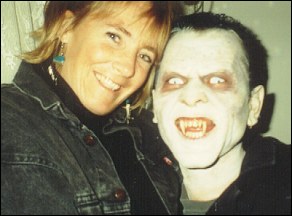 |
|
Mike and Mary Elizalde on Halloween. Original Vampire makeup design by Mike Elizalde. |
![]() So, the first full figure kit is the Netherlord?
So, the first full figure kit is the Netherlord?
![]() Yes, we're going to do four full
figures and four busts. The first in the bust series is Alex the Vampire. And I'm
currently working on sketches for the other three of each series. The next one
will probably be a werewolf. We also offer three full size masks that you can
get as either wearable or foam filled display copies. They were sculpted by
Jordu Schell. I've known Jordu for a while and I really like his work. He is an
excellent sculptor. I wanted to make him part of our company somehow. So I
approached him and said, "Why don't you let me take some of your masks to
the Chiller Theatre Convention and see what kind of response you get?" And
from that we decided to let Spectral Motion release his designs. Right now
he's working on a fourth design for us. It's going to be a really elaborate alien.
We feel very fortunate to have him with us, he's a great talent in the industry.
Yes, we're going to do four full
figures and four busts. The first in the bust series is Alex the Vampire. And I'm
currently working on sketches for the other three of each series. The next one
will probably be a werewolf. We also offer three full size masks that you can
get as either wearable or foam filled display copies. They were sculpted by
Jordu Schell. I've known Jordu for a while and I really like his work. He is an
excellent sculptor. I wanted to make him part of our company somehow. So I
approached him and said, "Why don't you let me take some of your masks to
the Chiller Theatre Convention and see what kind of response you get?" And
from that we decided to let Spectral Motion release his designs. Right now
he's working on a fourth design for us. It's going to be a really elaborate alien.
We feel very fortunate to have him with us, he's a great talent in the industry.
 |
 |
|
Netherlord's humble beginnings... He used to be a dragon! |
Netherlord in progress. Sculpture in Roma #4. |
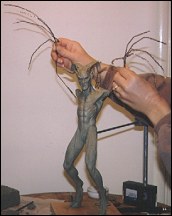 |
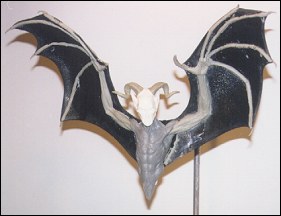 |
| Netherlord wing armature being fitted. |
Vacum formed wing membranes with arms and fingers sculpted in Roma. |
![]() Were these designs already completed as his portfolio pieces?
Were these designs already completed as his portfolio pieces?
![]() No, he had at
one point his own production company and he produced the masks for that
venue. I'm not sure of the specifics of what happened but the company is no
longer in production. So he had the molds already done and ready to go. The
way I feel about these masks whether they are the wearable variety or not, is
that you are getting a collectible piece of art, done from start to finish by the
original artist. It's a wonderful display piece as far as I'm concerned. I mean, I
would certainly buy one if I were out there.
No, he had at
one point his own production company and he produced the masks for that
venue. I'm not sure of the specifics of what happened but the company is no
longer in production. So he had the molds already done and ready to go. The
way I feel about these masks whether they are the wearable variety or not, is
that you are getting a collectible piece of art, done from start to finish by the
original artist. It's a wonderful display piece as far as I'm concerned. I mean, I
would certainly buy one if I were out there.
![]() Tell us a little about your sculpting techniques. How do you go about doing a
full-figure kit?
Tell us a little about your sculpting techniques. How do you go about doing a
full-figure kit?
![]() Well, I didn't do any research about how other people were
doing kits. I used Roma Plastilina clay which I will never do again. I found out
the hard way that it doesn't hold up. I just approached this as I would a
sculpture for special effects. As though this were a fully detailed maquette say
for a full-body suit or animatronic creature. What I do first is create scale
drawings to help in making an armature. So for instance, if I was doing a
human figure I might take photographs of someone as my model. Then I would
use an overhead projector to make the image on a wall to trace out a drawing
on paper that would be the appropriate scale. Then I would build the armature
according to these drawings, creating a skeleton that fits inside these outlines.
I use steel wire in the fingers because it's firmer than standard aluminum
armature wire. I used twisted aluminum armature wire for the bulk of the body,
legs, arms, etc. Then I unify it and bulk up the chest, pelvis, etc. with dental
acrylic. For joints, I use square brass tubing stock in order to make male-
female sockets that will allow me to remove parts such as the head, wings,
etc. This allows me to sculpt from any angle on a head or hands and get
extremely detailed. The brass tubing is connected to the rest of the armature
by crimping and using dental acrylic. For instance, on Netherlord his head was
sculpted separately and this allowed us to also mold it separately which aids
in the prevention of having air bubbles trapped in the castings. Then you can
make a small mold of just one part.
Well, I didn't do any research about how other people were
doing kits. I used Roma Plastilina clay which I will never do again. I found out
the hard way that it doesn't hold up. I just approached this as I would a
sculpture for special effects. As though this were a fully detailed maquette say
for a full-body suit or animatronic creature. What I do first is create scale
drawings to help in making an armature. So for instance, if I was doing a
human figure I might take photographs of someone as my model. Then I would
use an overhead projector to make the image on a wall to trace out a drawing
on paper that would be the appropriate scale. Then I would build the armature
according to these drawings, creating a skeleton that fits inside these outlines.
I use steel wire in the fingers because it's firmer than standard aluminum
armature wire. I used twisted aluminum armature wire for the bulk of the body,
legs, arms, etc. Then I unify it and bulk up the chest, pelvis, etc. with dental
acrylic. For joints, I use square brass tubing stock in order to make male-
female sockets that will allow me to remove parts such as the head, wings,
etc. This allows me to sculpt from any angle on a head or hands and get
extremely detailed. The brass tubing is connected to the rest of the armature
by crimping and using dental acrylic. For instance, on Netherlord his head was
sculpted separately and this allowed us to also mold it separately which aids
in the prevention of having air bubbles trapped in the castings. Then you can
make a small mold of just one part.
![]() On Netherlord, were the wings sculpted and cast separately as well?
On Netherlord, were the wings sculpted and cast separately as well?
![]() The
wings were done after the sculpture was completed. I had it molded and had
a casting of the torso made of resin to work with. The first mold of the torso
was made by Mark Garbarino. I took this torso and created a vacuum form
tool around that, so that you could vacuum form a thin material onto a
presculpted shape. It's interesting that Netherlord actually started out as a
dragon. I got really frustrated with what I was doing and ended up tearing the
head off. So he was no longer a dragon, but he was still this towering form.
The
wings were done after the sculpture was completed. I had it molded and had
a casting of the torso made of resin to work with. The first mold of the torso
was made by Mark Garbarino. I took this torso and created a vacuum form
tool around that, so that you could vacuum form a thin material onto a
presculpted shape. It's interesting that Netherlord actually started out as a
dragon. I got really frustrated with what I was doing and ended up tearing the
head off. So he was no longer a dragon, but he was still this towering form.
![]() So it wasn't necessary for you to change your armature?
So it wasn't necessary for you to change your armature?
![]() No, my dragon had
a very human-like torso and long legs. So it wasn't very difficult to make the
transition into the Netherlord from that sculpture. It took me about a month to
complete the sculpture, which sounds like a long time. But I was taking my
time with it because I really didn't have a deadline except for one that I was
imposing on myself. I had never really sculpted a full figure before. Most of my
sculpture had been on life castings of people for appliance work or other full
size pieces. I hadn't
really done a maquette before, so this taught me a lot about anatomy. The
molds for Netherlord were done for me by Ralph Cordero and his wife, Lisa.
They did a beautiful job. They also did the first 25 castings for me.
No, my dragon had
a very human-like torso and long legs. So it wasn't very difficult to make the
transition into the Netherlord from that sculpture. It took me about a month to
complete the sculpture, which sounds like a long time. But I was taking my
time with it because I really didn't have a deadline except for one that I was
imposing on myself. I had never really sculpted a full figure before. Most of my
sculpture had been on life castings of people for appliance work or other full
size pieces. I hadn't
really done a maquette before, so this taught me a lot about anatomy. The
molds for Netherlord were done for me by Ralph Cordero and his wife, Lisa.
They did a beautiful job. They also did the first 25 castings for me.
![]() Tell us a little bit about your Alex the Vampire bust.
Tell us a little bit about your Alex the Vampire bust.
![]() That started out as a very
detailed drawing and my intention is to do it as a make-up effect. So I looked
at the sculpture of the bust as if it were a maquette for a special effect. I
decided to use Chivant clay this time because Roma proved to be not the
best clay to work with. I'm not sure what billet number of hardness I used but I
begin by slicing it all up into very small pieces, warming it, then blocking out
the basic sculpture.
That started out as a very
detailed drawing and my intention is to do it as a make-up effect. So I looked
at the sculpture of the bust as if it were a maquette for a special effect. I
decided to use Chivant clay this time because Roma proved to be not the
best clay to work with. I'm not sure what billet number of hardness I used but I
begin by slicing it all up into very small pieces, warming it, then blocking out
the basic sculpture.
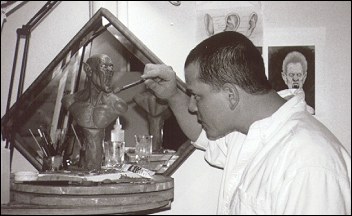 |
|
Adding final detail (pore stipple) to the Alex The Vampire bust. |
![]() When you do skin texture detail, veins, etc. do you use the technique of
sculpting through plastic wrap?
When you do skin texture detail, veins, etc. do you use the technique of
sculpting through plastic wrap?
![]() No, a stippling technique. I don't use
cellophane. I sculpt directly on the clay with a small loop tool, with a ball of clay
at the very end of the tool for weight. This gives you a little bit more of inertia
working in your favor. And that's how I stipple very lightly over the surface of
the clay and that creates pore details, etc.
No, a stippling technique. I don't use
cellophane. I sculpt directly on the clay with a small loop tool, with a ball of clay
at the very end of the tool for weight. This gives you a little bit more of inertia
working in your favor. And that's how I stipple very lightly over the surface of
the clay and that creates pore details, etc.
![]() Do you then use solvents and brushes to remove unwanted tool marks?
Do you then use solvents and brushes to remove unwanted tool marks?
![]() Yes, I
like to pride myself on not using a whole lot of alcohol or solvents to clean up
my work. I like to sculpt it to the point where I think it's ready. Next, I just take a
very light sable brush and dip the brush in alcohol and clean it off until it's
almost dry. Then I very lightly polish the surface of what I sculpted. So the
brush is intended more to polish than clean up tool marks. I use 99% isopropyl
alcohol. Also, after I use the alcohol, I brush down the sculpture with another
sable brush dipped in water to clean off the residue. Now it's ready for
molding.
Yes, I
like to pride myself on not using a whole lot of alcohol or solvents to clean up
my work. I like to sculpt it to the point where I think it's ready. Next, I just take a
very light sable brush and dip the brush in alcohol and clean it off until it's
almost dry. Then I very lightly polish the surface of what I sculpted. So the
brush is intended more to polish than clean up tool marks. I use 99% isopropyl
alcohol. Also, after I use the alcohol, I brush down the sculpture with another
sable brush dipped in water to clean off the residue. Now it's ready for
molding.
![]() When I have used Roma clay for a sculpture and then proceeded to
make a stone mold, I sprayed the sculpture with a layer of Krylon Crystal Clear
to give it a thin plastic coating. Do you do this?
When I have used Roma clay for a sculpture and then proceeded to
make a stone mold, I sprayed the sculpture with a layer of Krylon Crystal Clear
to give it a thin plastic coating. Do you do this?
![]() No, I don't use any separating
agent on the Chivant. I recommend this clay highly. It creates such a wonderful
surface and no mold release is necessary when making silicone molds.
No, I don't use any separating
agent on the Chivant. I recommend this clay highly. It creates such a wonderful
surface and no mold release is necessary when making silicone molds.
![]() Did you mold Alex or did the Corderos?
Did you mold Alex or did the Corderos?
![]() I did. It is a one piece mold with a zig-zag cut up the back so it flexes
open. This makes very clean castings with a minimal seam in the back.
I did. It is a one piece mold with a zig-zag cut up the back so it flexes
open. This makes very clean castings with a minimal seam in the back.
![]() Are you doing your own castings now, after the first 25 were done, for
Netherlord?
Are you doing your own castings now, after the first 25 were done, for
Netherlord?
![]() Yes, I'm doing my own castings. I want to keep most production
in-house for quality control, not that I have any complaints about those first 25
castings. But this works out best for me with my schedule. I can always bring
in help when I need it. I use Vagabond brand triple X very slow urethane for
my castings. It doesn't gel for 4 or 5 minutes which gives me enough time to
fill the molds, put them on a rack, and lower them into the pressure pot. I
pressurize it to about 60psi. I've had a lot of fun casting the stuff up myself. It's
really cool to pull out a copy of something you sculpted yourself.
Yes, I'm doing my own castings. I want to keep most production
in-house for quality control, not that I have any complaints about those first 25
castings. But this works out best for me with my schedule. I can always bring
in help when I need it. I use Vagabond brand triple X very slow urethane for
my castings. It doesn't gel for 4 or 5 minutes which gives me enough time to
fill the molds, put them on a rack, and lower them into the pressure pot. I
pressurize it to about 60psi. I've had a lot of fun casting the stuff up myself. It's
really cool to pull out a copy of something you sculpted yourself.
![]() On an average day, what is your production like?
On an average day, what is your production like?
![]() Well right now I'm working at
Rick Baker's studio on the film, Mighty Joe Young, so I get home in the
evening, have dinner and unwind for a while. Then I go out in the garage and I
clean up the mess from the previous night. I make it a point to prepare the
molds the night before, so they're already mold-released, closed up and
ready to pour. I turn on the compressor to build up the pressure in the air
chamber. I take down my pre-marked measuring containers for each of the
molds. This way, I know how much A and B to mix up so as not to overflow the
molds. It takes up about an hour to cast up one Alex the Vampire bust kit, and
about the same amount of time to cast up a Netherlord kit. So, on an average
night of production, I'll do maybe three Alex the Vampires and one Netherlord
kit, or 2 Netherlords and 1 Alex, depending on how many orders we've got.
So that's generally how that goes.
Well right now I'm working at
Rick Baker's studio on the film, Mighty Joe Young, so I get home in the
evening, have dinner and unwind for a while. Then I go out in the garage and I
clean up the mess from the previous night. I make it a point to prepare the
molds the night before, so they're already mold-released, closed up and
ready to pour. I turn on the compressor to build up the pressure in the air
chamber. I take down my pre-marked measuring containers for each of the
molds. This way, I know how much A and B to mix up so as not to overflow the
molds. It takes up about an hour to cast up one Alex the Vampire bust kit, and
about the same amount of time to cast up a Netherlord kit. So, on an average
night of production, I'll do maybe three Alex the Vampires and one Netherlord
kit, or 2 Netherlords and 1 Alex, depending on how many orders we've got.
So that's generally how that goes.
![]() So the make-up effect based on Alex the Vampire will be done on an actual
human being and will premiere at the Mad Model Party?
So the make-up effect based on Alex the Vampire will be done on an actual
human being and will premiere at the Mad Model Party?
![]() Yes, if our schedule
permits. I just completed the life casting with the help of Glen Griffin from Rick
Baker's shop. I'm about to begin the sculpture on that. I'm also working on the
other kits in our line. So for the time being, our plan is to have four full-figure
kits and four busts for a total of 8 kits as well as Jordu's masks available from
Spectral Motion, and of course we are looking forward to the opportunity to
start doing our own effects films eventually.
Yes, if our schedule
permits. I just completed the life casting with the help of Glen Griffin from Rick
Baker's shop. I'm about to begin the sculpture on that. I'm also working on the
other kits in our line. So for the time being, our plan is to have four full-figure
kits and four busts for a total of 8 kits as well as Jordu's masks available from
Spectral Motion, and of course we are looking forward to the opportunity to
start doing our own effects films eventually.
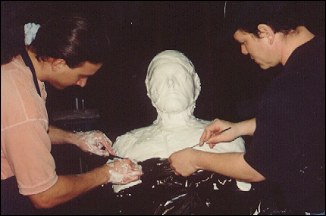 |
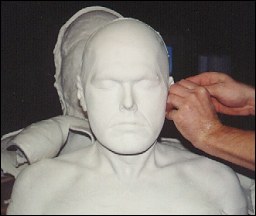 |
|
Mike Elizalde and Glen Griffin creating a life cast of Jurgen Heimann for the Alex makeup. |
The completed lifecast. |
The Gremlins in the Garage webzine is a production of Firefly Design. If you have any questions or comments please get in touch.
Copyright © 1994-1997 Firefly Design.